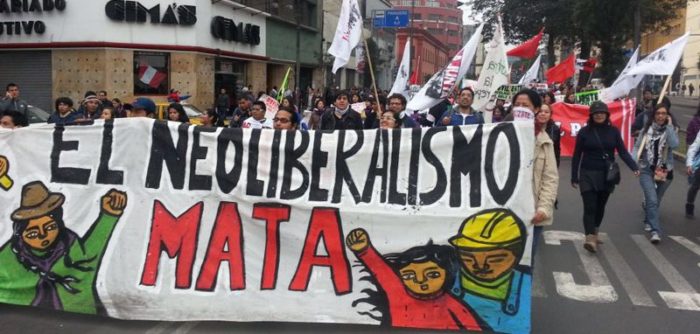
In December of last year, the International Monetary Fund (IMF) put out a blog post with the intriguing title of ‘When Inequality is High, Pandemics Can Fuel Social Unrest.” A more detailed working paper can be downloaded from the blog post.
That the IMF, as a leading institution of global capitalism and the neoliberal order, would turn its attention to the issue of social unrest is not entirely surprising. However, its pose of scholarly and dispassionate distance from the issue is really far too modest. The IMF has had a much more robust role in creating social explosions than it cares to admit. In the 80s and 90s, the fund’s brutal ‘structural adjustment programmes, which imposed austerity, privatisation and deregulation’ on poor and oppressed countries, led to such levels of social unrest among hard hit populations that the term ‘IMF Riots’ was coined.
The same considerations emerge in the more recent past. The IMF working paper points out that,
“The aftermath of the Global Financial Crisis (GFC), with the slow recovery and rising inequality, left tens of millions of people behind with fading hope of climbing up the social ladder. Many took their frustration to the street, contributing to an elevated level of citizen activism 10 years after the crisis. In 2019, popular protests erupted in France and Greece in Europe, Hong Kong and India in Asia, Chile, Colombia and Bolivia in Latin America to Iran and Iraq in the Middle East.” (p.4)
Yet, once again, it is simply too retiring when it comes to its own role in generating this seething discontent. In December of 2019, the Bretton Woods Project, observed that,
“Recent months have proven particularly tumultuous for the IMF, with thousands taking to the streets around the globe to demand change. Against a turbulent backdrop in Latin America, IMF-backed policies have triggered civil unrest across the region, resulting in civil society organisation (CSO) Latindadd spearheading a joint statement to the IMF in October condemning the “familiar austerity policies” that have led to “devastating economic and social impacts.”
The IMF’s bashfulness notwithstanding, its working paper most definitely reveals a keen interest in getting a handle on the threat of social unrest that lies ahead. The conditions that provide the fuel for a major round of unrest are set out quite clearly.
“The COVID-19 pandemic is worsening existing socio-economic inequalities. The virus pushed economies into a Great Lockdown, which triggered the worst recession since the Great Depression (IMF, 2020a; Deb et al. 2020). The lockdown measures have taken a huge toll on the labor market, with surging unemployment and plunging labor force participation. Job losses are concentrated in industries with lower wages and among women and youth, indicating early signs of worsening distributional outcomes.” (p.4)
The paper suggests that, with the exception of the Black Lives upsurge in the US (which produced international reverberations that are disregarded) and disturbances in Lebanon, the conditions of lockdown have tended to suppress disturbances. This conclusion was rather premature since a social resistance of historic proportions has subsequently emerged in India in the form of the farmers’ struggle against the Modi regime. There has also been a youth led movement in Tunisia and both of these have taken place as the pandemic continues to rage across the globe.
The authors of the paper seek to bring the highest level of scientific precision to their effort to chart the processes by which human misery becomes unendurable and masses of people are driven to confront an often brutal authority that stands in their way. They work with a ‘civil disorder score’ that ranges from 0 to 4 (p.6) and wax profoundly algebraic in the course of their learned exercise (p.7). They arrive at the conclusion, with 90% confidence, that, ‘Pandemic events lead to significantly higher risk of civil disorder after 14 months. Five years after the pandemic, civil disorder is about 0.1 point higher than the pre-shock level.’ (p.8) They express the fear that social unrest initiated by people less rational than IMF economists, having been sparked by economic adversity, is likely to cause further dislocation that will undermine business operations, fuelling further unrest and generating a ‘vicious cycle.’ (p.12)
In wrapping up their study, the writers conclude that the pandemic is making inequality worse and that, since other less severe pandemics have created unrest, this one threatens to be an even worse catalyst for disorder. They piously declare that, ‘Policymakers need to pay special attention to preventing scarring effects on the livelihoods of the least advantaged in society.’ (p.13) Being less given to rhetorical flourish than the Davos set, they don’t sing the praises of ‘inclusive capitalism’ but they conclude their paper with a sober nod in that direction.
Missing Conclusions
The concern that the IMF has with the threat of social unrest is entirely justified but, though I can’t set my arguments to algebra, I feel they’ve missed the boat on three important questions that I’d like to take up.
Firstly, they are not fully comprehending the enormity of the crisis they are considering. COVID 19 is not just a slightly bigger medical problem than what has gone before. It will cast its shadow over the global economy for a long while and, moreover, it is an expression of a distorted relationship with nature that has ushered in what the UN calls the ‘era of pandemics.’ On top of this, the economic crisis that the pandemic has triggered and intensified, was developing before anyone contracted COVID and these underlying problems, along with the ‘economic scarring’ the lockdowns have created, will long outlive the period in which the virus is a threat. Moreover, a worsening climate and broader ecological crisis hangs over everything and utterly precludes a return to stability.
Secondly, the IMF’s hypocritical nonsense about prudent policymakers challenging inequality and creating tolerable conditions of life that will eliminate the threat of social unrest must be rejected out of hand. The post pandemic reality will be marked by a global struggle over who pays for the crisis and the IMF will be on the side of the exploiters in that struggle. A kinder, gentler capitalism has never been a more unrealistic notion that it is at present.
Thirdly, and by way of a concluding point, the IMF’s view of social unrest, as episodes of messy and disruptive antics by the lower orders that are bad for business but can be contained with the help of preposterous algebraic formulas, is wrong. Those vital upsurges of entirely justified anger can be taken to another level, given a political direction and pose the prospect of social transformation. The issue is to go from raging against the world order the IMF is part of and to topple it. The period ahead must be defined by social unrest, on a scale and in a form, the writers of this paper and those they answer to simply didn’t see coming.
